“Happiness is a place.” This is the slogan of Bhutan’s tourism campaign which I saw in increasing frequency as soon as I arrived in this Himalayan kingdom. Many people travel long distances to Bhutan in search for happiness, something they can’t quite find amid the modern trappings of their lives. Happiness is so synonymous with Bhutan, some even claim that this small country has the happiest people in the world.
However, what Kinga explained to us throughout our journey in western Bhutan gave us deeper insights into what this pursuit of happiness is all about.
Our second day in Thimphu began with a short stop at a viewpoint where we could see Tashichho Dzong with golden rice paddies gloriously bathed in the warm morning sun. Most of the Bhutanese capital, Kinga said, used to look like this. However, as more and more people move from the countryside to Thimphu, the area of the city’s arable land shrinks as the demand for housing keeps increasing – though all of them must adhere to a regulation mandating all structures in the country to be built using traditional Bhutanese architectural elements, a standard which applies even to international luxury resorts.
In a TED Talk given two years ago, Tshering Tobgay, Bhutan’s former prime minister, mentioned how the fourth king of modern Bhutan formulated a new approach to measuring progress which focused on balancing economic growth with careful social development, environmental sustainability and cultural preservation. This concept became known as Gross National Happiness (GNH), and the world has been captivated by it ever since.
The main architect of Bhutan’s foundation for preparing the country to embrace the future is Jigme Singye Wangchuck, the kingdom’s fourth monarch who ascended the throne in 1972 when he was only 17 following the death of his father, the third king. Taking up what the previous king had left unfinished, especially with regard to ending Bhutan’s isolation and leading the country toward modernization, Jigme Singye Wangchuck pioneered a new approach to growth. “Gross National Happiness is more important than Gross National Product” is his most widely quoted remark made during an interview in the early years of his reign. Later he also stressed the importance of attaining self-reliance and preserving Bhutan’s sovereignty and independence which, coincidentally or not, was addressed just one year after anti-royalist riots took place in neighboring Sikkim, another Buddhist kingdom in the Himalayas. Sikkim was eventually absorbed into India as its Hindu population outnumbered Buddhists, an event that might have contributed to the expulsion of more than a hundred thousand Nepali-speaking citizens across southern Bhutan in the 1990s.
With Phuntsho taking the wheel of our white minivan, we sped across the capital while avoiding the downtown area. “We won’t go through the city center because it’s rush hour,” Kinga explained. Coming from Jakarta, I bet rush hour in Thimphu would feel like a weekend in the Indonesian megalopolis. We were going to a ridge in the south of the city where a colossal Buddha statue sits midway up the hillside, prominently visible from any point in Thimphu. Built in time to mark the fourth king’s 60th birthday, this gleaming monument couldn’t have been a more conspicuous display of the deep reverence toward Jigme Singye Wangchuck and the importance of Buddhism as the state religion.
Kinga elucidated what the fourth king had done to his kingdom, from introducing democracy to enacting a constitution many people around the world would perceive as progressive. “’The king invited people from all walks of life to take part in the drafting of the constitution, including monks, students, and local and foreign experts.” The end result was a wide-ranging constitution which dictates, among other things, how at least 60% of the country must remain covered in forests.
“Democracy is something people in other countries fight for, but in Bhutan it was imposed by the king. When the fourth king toured the country to introduce it, a lot of people were really sad because they thought it was the end of the monarchy,” Kinga added.
Bhutan held its first general election for the National Assembly in 2008 and the democratic process has been thriving with the latest election occurring in mid-October, less than a week after my visit to the country. However, despite formally being no longer an absolute monarch, the king still retains his power in some areas, including appointing the judges of the Supreme Court, the chief of the anti-corruption body, and the CEO of the national holding and investment company, Druk Holding & Investments (DHI). One interesting article in the constitution requires the king or queen to retire at the age of 65, and should the nation have an unpopular monarch, he/she can be forced to abdicate with a two-thirds majority vote by the directly elected parliament members. This provision was purposefully included in the constitution to prevent future kings or queens from abusing their power.
“The fourth king himself abdicated when he was 51 years old. And now he’s often seen cycling around the country,” Lotay, the co-owner of the tour company we took, later told us.
The Bhutanese certainly didn’t embrace democracy wholeheartedly, and what I read on Kuensel – Bhutan’s English-language newspaper which was available on the flight from Singapore – confirmed that its negative impacts have become a growing concern among the people. Candidates from both parties competing in the latest election were generally on the same page about how attacking the other’s programs rather than focusing on one’s own was among the things they disliked about the campaign stage. Some were upset that the election process had caused division among the people. This indeed happens in places that practice democracy, although it seems to remain the best means to prevent the concentration of too much power in just one person or party.
From the same newspaper I learned a fact I was never aware of: Bhutan has a growing national debt that is becoming a bigger problem over time, and this issue was used by politicians from both sides to convince the people to vote for them. However, Lotay, who together with his brother started their travel business after finishing their studies in the U.S., convinced us that the king will always safeguard democracy in Bhutan.
“Democracy is like a ship, and the king is its anchor.”
Self-reliance is a recurring theme several politicians used for their campaigns, and some short visits to artistic workshops across Thimphu provided us with a glimpse of what the Bhutanese are capable of creating. First, Kinga took us to the National Institute for Zorig Chusum where young people study craftsmanship and artistry, obviously all in Bhutanese traditional style as it is an important aspect of GNH. Across the river, Kinga showed us a small factory where papers are made using simple machinery. Witnessing how the staff members carefully made thin layers of paper by sifting through a murky white concoction of daphne pulp, before gently releasing a wet sheet onto a neat pile, was not only fascinating, but somehow also therapeutic.
On our way to the place where we would have lunch, Phuntsho stopped by a tall white chorten (Bhutanese style stupa) whose spire gleamed with a bright sheen. We were at the Memorial Chorten, completed in 1974 to honor the third king, Jigme Dorji Wangchuck. Around the chorten’s base, pilgrims – mostly the elderly – draped in gho (for men) and kira (for women) circumambulated several times below the midday sun. Some of them sought refuge in a shaded corner of the compound while spinning giant prayer wheels. “When you see a lot of old people gather around the chorten like this, usually the following day there will be a festival,” Kinga told me. Unfortunately the next day we were scheduled to leave for Punakha, a two-hour drive to the east of the capital.
We left the chorten and headed to a district with a pockmarked road that led to what seemed to be a commercial area, where we disembarked first while Phuntsho tried to find a space just large enough to park the minivan. Kinga led us to one of the multi-story buildings, which upon closer inspection was in fact an old shopping center, with its shops mostly closed and its corridors deserted. We ascended a flight of stairs to the second floor, and there it was, a rather humble venue to have another round of the local cuisine.
Already quite familiar with the names of some Bhutanese dishes, James and I ordered ema datshi, shamu datshi, and suja. While waiting for the food to arrive, I paid attention to the restaurant’s ornaments, its old window, and the overall ambiance of the place. Had Kinga and Phuntsho not brought us here, we wouldn’t have known to visit this restaurant in the first place. Soon enough they both joined us and Kinga ordered some more dishes for us to try. A few minutes later a young waitress came with a number of small bowls, each filled with different items which all looked delicious as my eyes ran through one cheese-based specialty to another. The suja was even creamier than what I had enjoyed the previous day, the ema datshi spicier and the other dishes equally tantalizing. We couldn’t have been happier that Bhutanese food turned out to be one of the highlights of this trip.
It was another filling lunch, and just like the day before we ended up with really full stomachs. But as we were about to leave the restaurant, Phuntsho gave us something I wasn’t too familiar with. “Dessert,” he said with a big grin. It was in fact a package of dolma, a mixture of areca nut, lime paste, and betel leaf which come individually but are chewed together to induce a stimulating effect on one’s body – and red-stained gums. Carefully we took one of each, wrapped them all together, and put the bundle inside our mouths and started chewing. We instantly looked at each other, surprised by how the combination of the three tasted; while I could handle the leaf and lime paste, it was the areca nut that was the hardest on the palate. “People in eastern Indonesia also have something similar to this,” I explained to Phuntsho while still struggling to mix the nut with the others. “But this is the first time I have had it,” I added. Phuntsho seemed to be amused, although right away he told us we could spit it out if we didn’t like it. Luckily, after that we only had sweet and juicy Bhutanese apples for dessert.
We then headed to the start of a trail which Kinga had told us about the day before, while I was still trying to wash down the bizarre sensation in my mouth from the dolma during our short ride. The trek at Sangaygang, the name of the hill, began just below a communication tower, and the rolling clouds above Thimphu’s skies unexpectedly provided us with a shade throughout most of the hike. Different species of birds chirped from the tree branches amid the canopy of the pine forest. This reminded me of Sri Lanka, a fellow Buddhist-majority country, where animals roam the land freely and safely without having to encounter much harassment inflicted by humans. However, in spite of this compassionate attitude toward sentient beings, Bhutan’s own national animal, the takin, is now a threatened species largely due to their shrinking habitat and competition from domesticated yaks.
At the end of our hike, the view of Thimphu unfolded right in front of our eyes, and before long the sun reappeared, giving us ample time to take photos of the Bhutanese capital from this dramatic vantage point. Although it’s not a big city to begin with – it has less than 120,000 people – Thimphu packed in a lot of interesting sights and experiences. We wished that we had more time to explore the capital, but the following day we had to leave for Punakha Valley, a notably different place from Thimphu. It was warmer over there and the dzong was even more ornate than the already impressive Tashiccho Dzong.
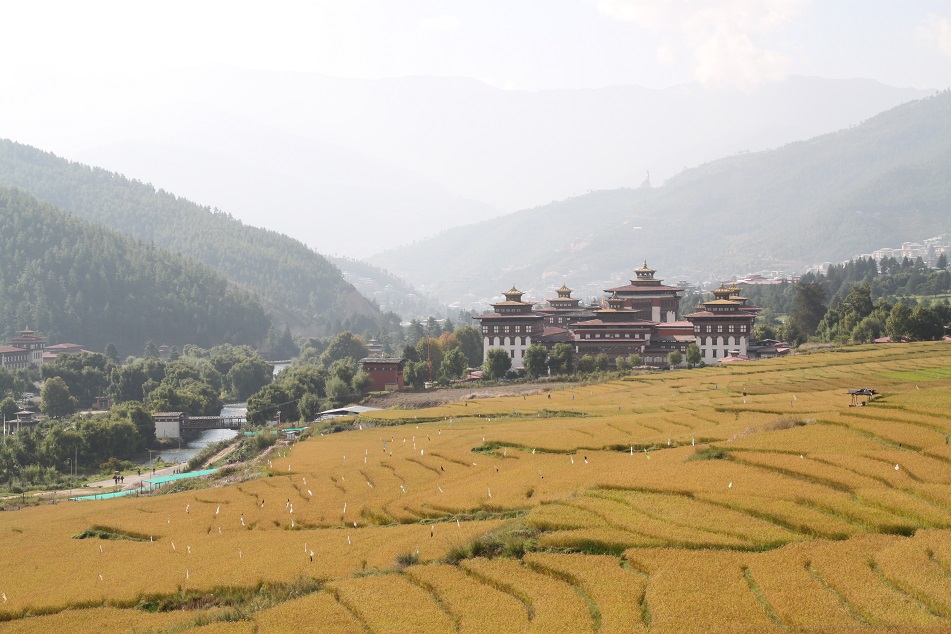

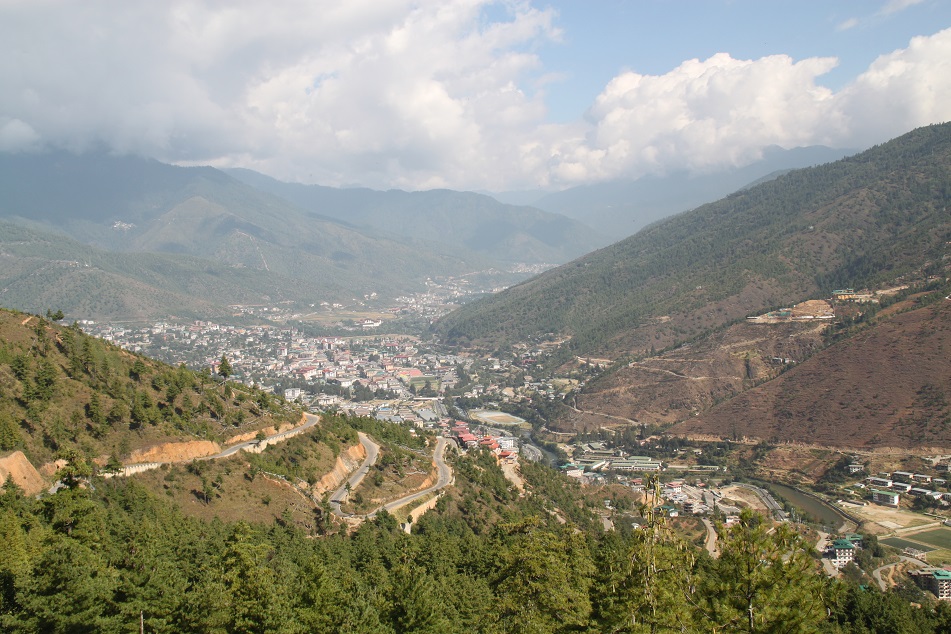

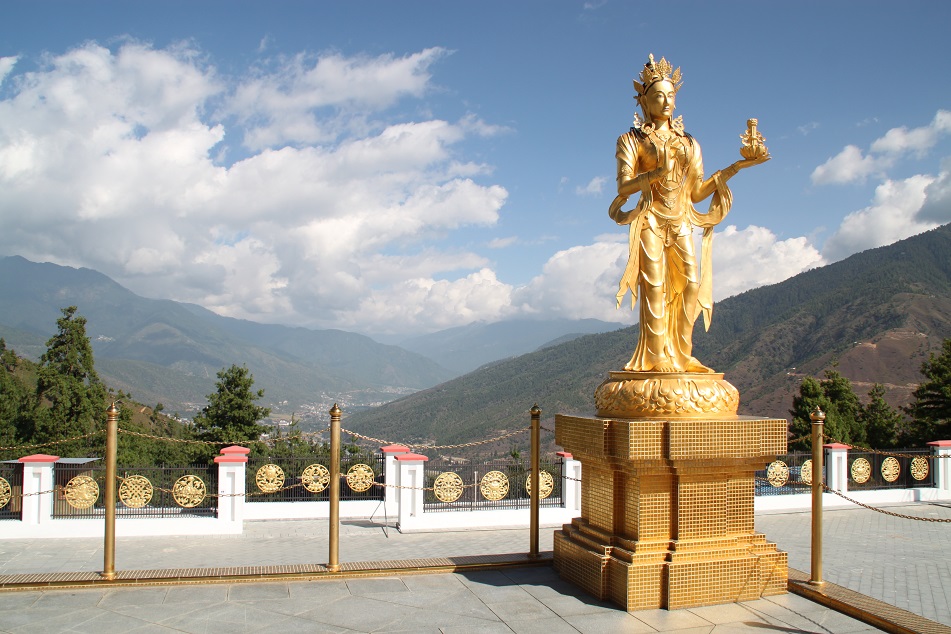



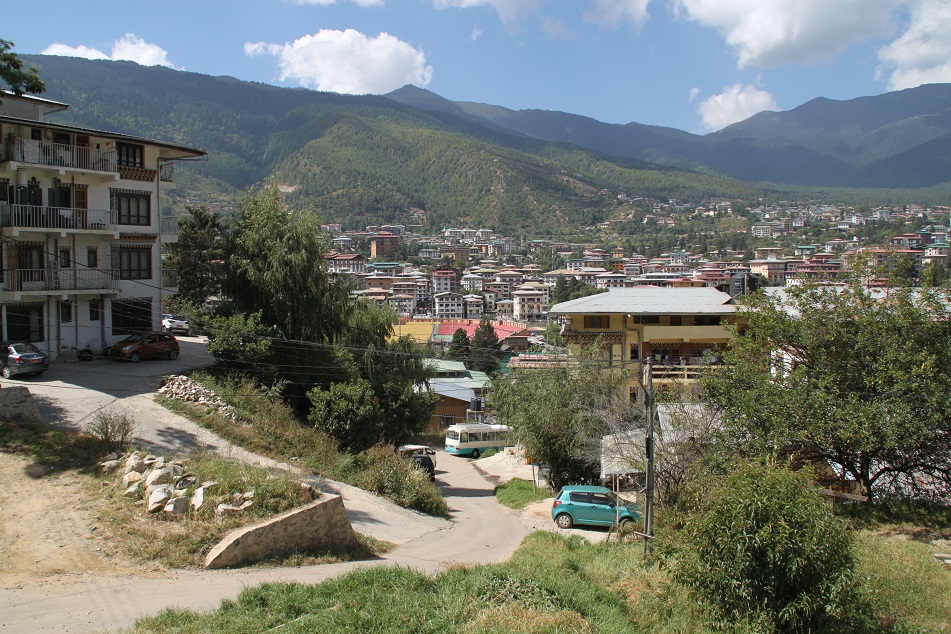



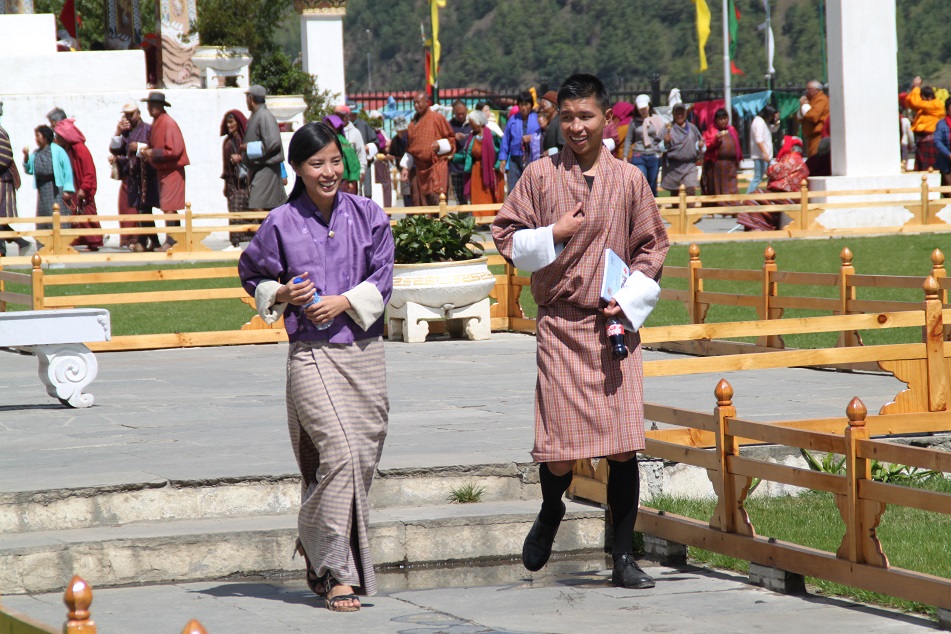

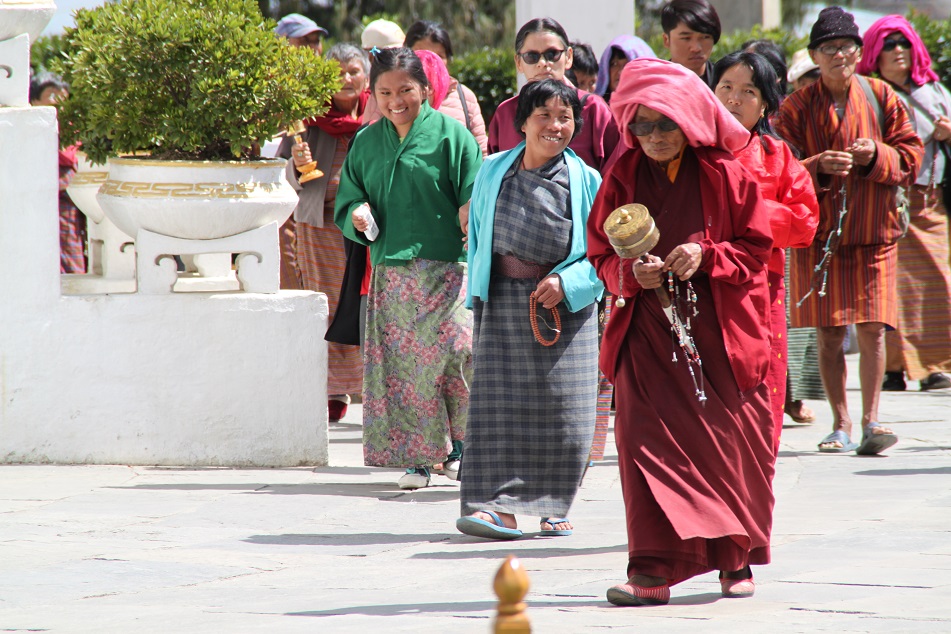

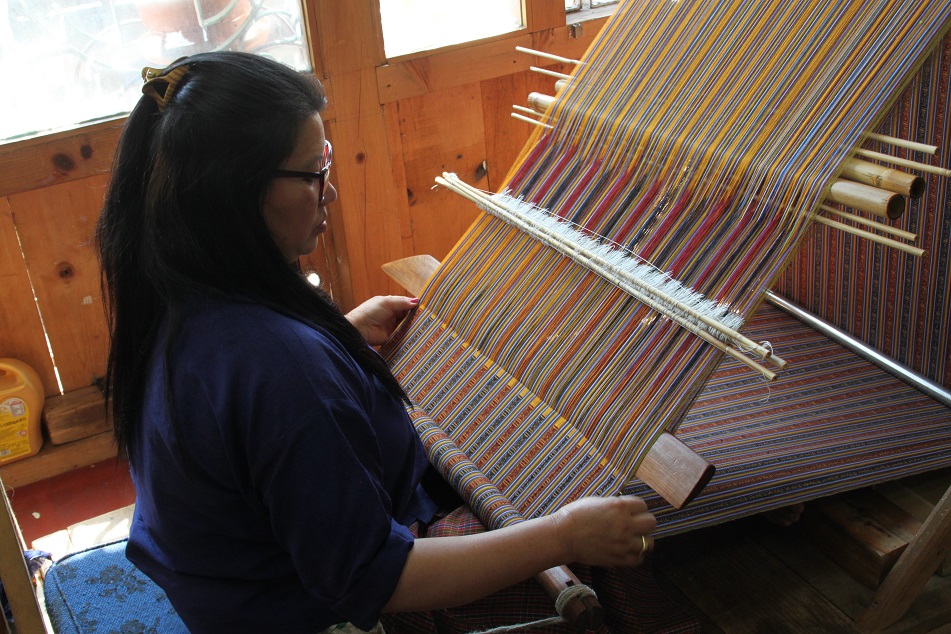




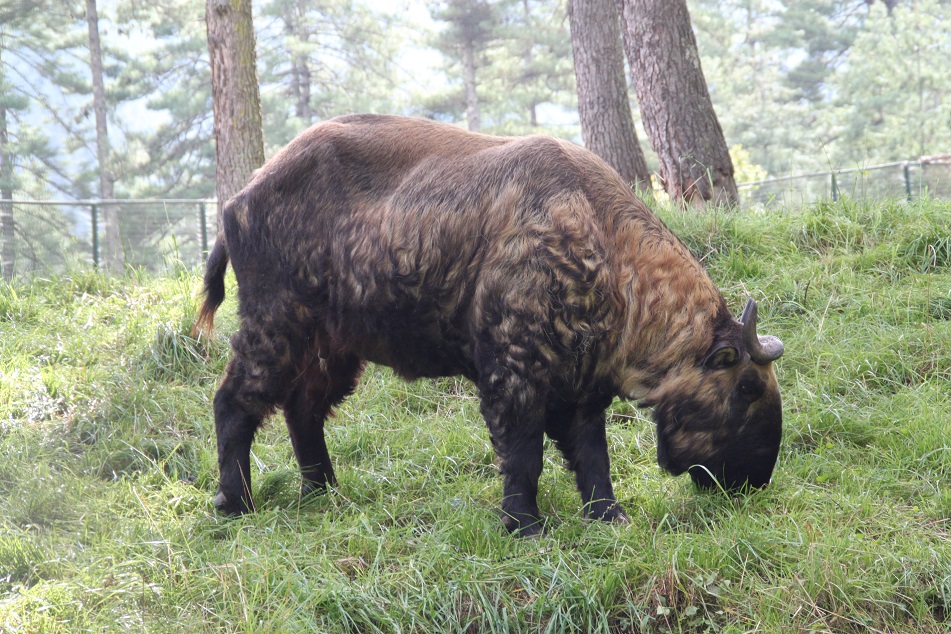






The photo of the Takin was fascinating to me. I always love your posts. Thanks so much.
LikeLike
Takin really is a unique animal. Some say it has the head of a goat and the body of a bull. Thanks for reading!
LikeLiked by 1 person
Sounds like a fascinating time. I’d love to go there. Great photos Bama, especially the one of the memorial chorten through the doorway.
Alison
LikeLike
Thanks Alison. You would love the natural landscape and cultural sights in Bhutan, although as a person who loves desserts you may be disappointed with what they have to offer. On the bright side, their meals were amazing!
LikeLiked by 1 person
Very interesting history…and great photos. Takes me back to my time in Mongolia and finding a new culture…food and all. Love it!! Nancy of Boyer Writes
LikeLike
The feeling is mutual; Mongolia is one of those countries I’ve been intrigued to visit, especially after going to Bhutan which shares the same history (related to Tibetan Buddhism) with the former. Thanks for reading, Nancy!
LikeLike
As ever, a deeply informative post with gorgeous photos to boot. It was so fascinating to hear from Kinga and Lotay about the recent socio-political changes that have taken place in Bhutan within the last 10-15 years. I loved our time in Thimphu and wouldn’t have minded staying an extra night to do some more hiking and sightseeing (and enjoy more of Auntie Ugyen’s fabulous home-cooked Bhutanese food!).
LikeLike
You know I’ve been paying more attention to Bhutan even after our trip because it’s interesting to follow all the developments in the country. If their GNH approach proves successful, it would be a great example for other countries to focus more on the overall well-being of their people rather than just the growth of their income. I agree, another night in Thimphu would have been great so we could explore more.
LikeLiked by 1 person
Is it just me or Thimpu is an incredibly clean place? I was looking at your photos, Bama, and if I compare it with London, or any European city, there are no discarded papers, no food wrappers, no cigarette butts, no abandoned cans of cheap beer.. Love the food photos but I bet that the dishes were at lot more fiery (in terms of spiceness) than they looked!
Fabrizio
LikeLike
Thimphu (and Bhutan in general) was very clean, although my eyes happened to spot a few empty plastic bottles in a gutter when I was exploring the city on foot. It made me think that even Bhutan is now facing a problem with plastic waste, although still at a very minimum level. However, the government should take actions to prevent this from getting bigger in the future. The chili dishes were actually quite spicy even for my Indonesian standard. That is not to say that you should avoid it altogether, Fabrizio, since every restaurant has its own recipe.
LikeLiked by 1 person
Were you on an organized tour or were you able to travel on your own? We’d love to visit but heard it’s very expensive to visit there.
LikeLike
Hi Steven and Annie. By regulation every foreign tourist in Bhutan must be accompanied by a guide. Luckily ours was quite flexible with the schedule and he would even give us ideas of the activities we could do in each valley. The levy is indeed very expensive, but after going there I realized that it’s for the country’s own good. I even think of some places in my home country which should impose the same kind of ‘tourist tax’.
LikeLike
” Happiness is a place”, you truly displayed that through your images and words. Thanks to you from your last post I got inspired again to visit Bhutan, and I had ordered the book of Matthieu Richard “Buthan”. through the link of the Ted Talk video.
LikeLike
Wow, I’m so happy that the video I shared with you inspired you to buy that book. I really hope you’ll get the chance to visit Bhutan soon enough, Cornelia. It was such a tranquil and beautiful place.
LikeLiked by 1 person
Thank you my wordpress friend
LikeLike
You’re very welcome.
LikeLike
What an interesting history of Thimphu you shared with us. I find the information about the concept of Gross National Happiness (GNH) very interesting and very different than what we use in western cultures. I would love to travel to Bhutan to try all those dishes especially the butter tea.
LikeLike
Definitely there are many things from GNH that we can learn about and replicate. To me the concept of GNH is a more humanizing way to measure progress, because after all our well-being is not necessarily reflected in the economic growth of our country. Speaking of the butter tea, each place has its own recipe, and this restaurant in Thimphu was my favorite because the butter didn’t taste too oily. It had just the right amount of everything.
LikeLiked by 1 person
Great summary of the happiness efforts in Bhutan, Bama. Back in my university teaching days, I regularly used an article about Bhutan’s GNH in my classes, so every semester I was reminded of my strong urge to visit! I’m still waiting to hear if anyone has joined the trip I signed up for in April; I’ll be very bummed if that peters out. Loved your photos of the city from above and all the beautiful people.
LikeLike
Bhutan’s GNH is indeed the reason for many people to visit the country — one of my ex-bosses is among them. I imagine if the world would be a better place if countries put more emphasis on GNH, meaning healthier citizens (less burden on the healthcare system), better conditions of the environment (contributing to long-term economic benefits), and more attention to cultural preservation (creating an even more colorful and diverse world), among other things. Fingers crossed there will be more people signing up for your trip. Spring is after all supposedly a good time to visit.
LikeLiked by 1 person
Mas, reading your post is like hearing a story from a tour guide while being guided to enjoy the whole city. It was very “rich”.
So, is that “desert” similar to “nyirih”? I’m curious about the public transportation in Thimphu. How is it?
LikeLike
As a matter of fact, I love being a guide for my close friends. There’s something exciting about sharing with them the information about a place I like. That dessert is indeed similar with nyirih in Indonesia. Have you tried it? As for the public transport, I saw the locals taking small buses to go to work. But tourists are required to have a guide and a driver as mandated by the regulation.
LikeLike
I think many travelers do. We love guiding people to places we know, sharing our information to them. So do I 😁😁😁
Never tried any “nyirih”. Well, we (my friends and I) think that ” nyirih” makes us look like an old man. And I don’t think it is tasty 😦
LikeLike
I wonder how similar/different the nyirih in Bhutan is from the one in Indonesia, and the only way to find out is to try! 🙂
LikeLiked by 1 person
Parahhhh bagus banget
LikeLike
Bangeet mbak. Mbak Noni kalau ke Thimphu pasti ‘kalap’ foto-foto deh. Setiap sudutnya cantik.
LikeLike
Really enjoying seeing Bhutan through your eyes Bama. Like others I would love to visit Bhutan.
LikeLike
Sue, I’m sure you would enjoy the hiking to Tiger’s Nest (more on that on a later post). We were told that the former king loves cycling, so maybe if you come to Bhutan one day you might want to loop up cycling opportunities across the country.
LikeLiked by 1 person
Potentially Bama but at the altitude we may be happy to just tour about. 🙂
LikeLiked by 1 person
Sebagai orang yang mulai sumpek dengan lalu lintas di Bogor, aku penasaran dengan rush hour di Thimpu dan beberapa kota di Bhutan lainnya. Soalnya aku lihat sepertinya jalanannya lengang dan santai-santai aja.
Btw, dirimu sempat lihat ada daun ganja yang dipakai gak di kertas tradisional itu?
LikeLike
Duh, rush hour di Thimphu mah gak ada apa-apanya dibandingin kondisi lalu lintas di kota-kota sekitaran Jakarta. Malah di deket pos polisi yang di tengah jalan itu ada beberapa anjing yang kalem aja gitu tidur di badan jalan.
Soal daun ganja, aku diceritain sama guide-ku kalau salah satu daun yang suka dipakai buat bahan tambahan kertas itu ya ganja. Tapi pas ke sana sih gak ada tanda-tanda daun ganja.
LikeLiked by 1 person
Nah di situ letak lucunya ya. Mereka sengaja menghindar dari area tertentu supaya gak terjebak jam sibuk. Sementara kita malah mungkin penasaran, pengen lihat puncak dari jam sibuk nya.
O iya, terus itu keberadaan polisinya signifikan gak Bam dalam pengaturan lalu lintas? Misalnya lajur mana yang berhenti dan mana yang jalan. Dan seberapa tingkat kepatuhan warganya?
Dan kalau aku lihat dari foto-fotomu ini. Tempat-tempat publik di Bhutan ini jauh lebih rapi ya, dibandingkan Nepal.
Kertas dengan aksen daun ganja itu, bisa jadi souvenir yang menarik tuh. Meskipun deg-degan juga kalau lewat bandara trus tiba-tiba ada random check 😀
LikeLike
Dari pengamatanku sih cukup signifikan sih, dalam artian mobil-mobil memang gantian melintas sesuai aba-aba dari sang polisi. Soal tempat publik, betul di Bhutan jauh lebih rapi dan lengang dibandingkan di Nepal. Wajar sih karena penduduknya cuma sepersekiannya Nepal.
Nah, berhubung waktu aku keluar dari Kathmandu tasku digeledah banget sama petugas di bandara (bahkan buku note book yang aku beli pun dibongkar plastiknya sama mereka karena khawatir mengandung zat psikotropika) padahal aku gak bawa daun ganja atau apapun yang terlarang, jadi aku sih bahkan gak berpikir untuk coba-coba beli kertas dengan daun ganja baik itu di Bhutan atau di mana pun. 😀
LikeLiked by 1 person
Cari amannya aja ya, daripada jadi masalah hehehe.
LikeLike
Betulll.
LikeLike
Fascinating read and beautiful photos Bama. I’m intrigued by the fact that the monarchy has to retire by age 65 and can be forced to abdicate…makes good sense. Your photos of the elderly pilgrims are wonderful as are all the delicious looking food items. As I may have mentioned in one of your previous posts, the prevelance of cheese surprises me. It seems unusual for this part of the world. What exactly is butter tea? What does it taste like?
LikeLike
Bhutan is exceptionally progressive at things like this — some supposedly ‘democratic’ countries can certainly take note. I just loved how colorful the gho and kira were, and seeing scenes like this always makes me think of how nice it would be if people in my own country choose to wear their traditional dresses more often. I have to look up the history of cheesemaking in Bhutan, but what I know they’re mostly made from cow’s or yak’s milk. As for butter tea, imagine black tea leaves mixed with yak butter, water and a little bit of salt. The flavor was velvety yet rich.
LikeLiked by 1 person
“What an Amazing Word” Indeed Bama! I really enjoyed reading this, and how your writing allowed the images in my mind to be as clear as the great photos that you took. I would definitely like to travel to Bhutan someday and be able to experience this amazing part of the world myself. The food dishes that you ate while you were there, they looked and from your description sounded delicious too. I am following you now so that I will be able to read about more of your travels!
LikeLike
Thank you for reading and leaving such a kind comment, Marcus. I’m glad that you could travel vicariously to Thimphu through my words and photos. Bhutan is a country that needs to be seen to be believed, and hopefully one day you’ll get the chance to go to this part of the world.
LikeLiked by 1 person
Isn’t this like the only example in history of a king abdicating and creating a democracy? People usually struggle for democracy instead of being sad when it is given to them.
GNH is a great concept. The eco-monks I hung out with last month talked about the same thing frequently. They want Thailand to develop to a moderate point, but keep the forests and slower pace of life. The world would be such a better place if all countries had to keep 60% forest and we focused on happiness and fairness vs. greed and progress.
LikeLike
As far as I know no other monarch has voluntarily introduced democracy because it means giving more power to the people. So yea, Bhutan’s fourth king was very progressive when it comes to things like this. I’m not surprised at all if more and more people in Thailand want to embrace GNH because both countries have a very close relationship, some there must have been exchanges of ideas among the governments and the people. Greed is certainly a bad thing, but progress when measured not only through numbers will help bring happiness — among the most progressive countries in the world (the Scandinavians) unsurprisingly happen to be among the happiest as well.
LikeLiked by 1 person
Mas Bama… aduh saya suka banget baca cerita ini sambil makan siang… ceritanya asik, fotonya bagus, jadi menetralisir makanan yang saya makan nih sehingga yang saya makan terasa lebih enak hahaha…. tapi beneran, baca postingan mas Bama itu emang paling enak sambil makan atau pas leha-leha di tempat tidur pagi-pagi hahaha..
LikeLiked by 1 person
Nah untung Mbak Riyanti bacanya pas makan siang. Coba kalau pas dalam keadaan perut kosong, kan bisa berabe. 😀 Kalau Mbak Riyanti suka makanan pedes, dan keju, pasti bakal suka makanan Bhutan. Pedes, gurih, dan creamy gitu rasanya.
LikeLiked by 1 person
A pretty impressive and unique destination. You are fortunate.
LikeLiked by 1 person
Bhutan is one of the most unique destinations I’ve been to, and its capital certainly is unlike any other world capitals.
LikeLike